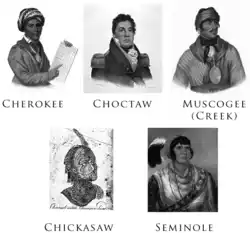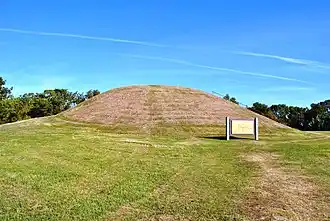
The Five Civilized Tribes was a name that was given to five Native American groups in the southeast of the United States in the nineteenth century. The five groups in question were the Cherokee, Chickasaw, Choctaw, Creek or Muscogee and the Seminoles. These groups generally inhabited the region around the modern-day states of Georgia, Florida, South Carolina, Alabama, Tennessee and Mississippi. These tribes had enough prolonged contact with the Europeans and were sedentary enough because of their own agriculture that they were portrayed as ‘civilized’ by European and American observers in the nineteenth century, in contrast to, for instance, the ‘wild’ Plains Indians further to the north with which the US government was almost constantly at war between the 1850s and the 1870s. As the US government conquered Florida and also began expanding westwards into the interior at the outset of the nineteenth century, relations with the Five Civilized Tribes became problematic and they were eventually forcibly displaced west of the Mississippi River as part of the Trail of Tears in the 1830s. Their descendants today are therefore to be found not just in the southeast of the US, but also in places like Louisiana, Texas and, especially, Oklahoma.[1]
Research your ancestors on MyHeritage
Five Civilized Tribes chronology of eventFive Civilized Tribes chronology of event

Often when we read about the Native Americans, they are portrayed as a homogenous group that inhabited the vast lands of what is the United States of America. This is not accurate. While there were some vaguely unifying cultural and even genetic factors amongst many Native Americans across the continent, there were more differences than similarities. These were dictated by geography and the resources that were available in each region in a lot of instances. For instance, the Plains Indians like the Sioux and Lakota in places the Dakotas, Nebraska and Montana, lived a largely pastoral life where their culture placed great emphasis on the hunting of buffalo and the use of horses after they were introduced to North America by the Spanish from Europe. Their lives were semi-nomadic at times as a result, because they had to adapt to the Spartan territory they lived in. Conversely, in the rather lush agricultural land of the East Coast, groups like the Powhatan and Algonquians were able to live through agriculture to a much greater extent. Corn, squash and beans were their staple crops. A third regional group, the natives of the Great Lakes region like the Huron or Wendat, were also less sedentary. Their situation was different again though. They often moved seasonally to hunt for beavers and other animals whose furs were prized by the French and English that they sold them to.[2]
This had an impact on how Europeans perceived the various Native American groups. In the early modern era, when colonization of North America commenced, agrarian agriculture and the development of settled towns and villages was viewed by Europeans as being intrinsic to being civilized, whereas a nomadic existence like that of hunters and pastoral farmers was viewed as being barbaric. For instance, we find the English in the sixteenth century describing the people of Ireland as barbaric because they moved seasonally as pastoral farmers to take their herds of cows to fresh pastures.[3] The English transferred this taxonomy of civility and barbarism to North America later on. They viewed groups like the Natives of the Great Plains as barbaric for moving around, whereas those on the East Coast and further inland from Georgia and the Carolinas were deemed to be more civilized, as they were sedentary, settled and engaged in agrarian farming (the planting of crops) rather than relying on pastoral farming (the tending of animals). The degree to which a given group was ‘civilized’ or not then became a justification for the conquest and colonization of their lands.[4]

The Five Civilized Tribes were amongst those considered to be civilized. These were the Cherokee, Chickasaw, Choctaw, Creek or Muscogee and the Seminoles. Broadly speaking, these groups inhabited the lands around the modern-day states of Georgia, Florida, South Carolina, Alabama, Tennessee and Mississippi. There was also a strong history of highly-developed culture and urban centers here in pre-colonial times. The Mississippi Culture, for instance, was a thriving one in which large cities like Emerald Mound had been built in the southeast in centuries gone by. Though the English and later the Americans knew little about this advanced pre-colonial culture, they did perceive the Five Civilized Tribes as being more civilized than their more nomadic brethren to the north.[5]
Because the English Thirteen Colonies of colonial times never included Florida, only gradually moved into Georgia from around the 1710s onwards, and remained fixed to the East Coast, they had only partial interaction with these groups. Consequently, unlike Native American tribes like the Algonquian Indians of New England and the Powhatan Indians of Virginia, they had not been displaced by the time the United States of America came into being in 1776. However, by the start of the nineteenth century, the country was looking to expand westwards towards the Mississippi River. At first the government attempted to engage in social engineering amongst these groups that would make them more amenable to allowing their lands to be settled by white settlers and to live among then. However, in the 1820s and 1830s a more aggressive approach was adopted by the government of President Andrew Jackson whereby the groups in question were to be forcibly transplanted westwards.[6]
Extent of migration of the Five Civilized TribesExtent of migration of the Five Civilized Tribes
The Indian Removal Act of 1830 ordered the vast majority of the Five Civilized Tribes to be removed west of the Mississippi River to make way for settlement of their lands by Americans and migrants from Europe. This initiated what the Cherokee came to refer to as the Trail of Tears, routes which were employed throughout the 1830s to move some 60,000 members of the Five Civilized Tribes westwards. It is estimated that upwards of 15,000 to 20,000 of these died as a result of food shortages, general brutality, and especially disease outbreaks as they were transplanted westwards.[7] Because of the death toll, this enforced relocation of the Five Civilized Tribes in the 1830s is viewed as being semi-genocidal today.[8]
Demographic impact of the movement of the Five Civilized TribesDemographic impact of the movement of the Five Civilized Tribes
The demographic impact of the forced transplantations was very substantial. While some Creek, Cherokee, Seminole, Choctaw and Chickasaw groups managed to withstand the pressure to move westwards and still have ancestors in places like Alabama, Georgia and Florida to this day, the vast majority were eventually removed. Therefore their descendants are overwhelmingly to be found in states like Louisiana, Texas and Oklahoma. Oklahoma, in particular, was selected as a region for Native American reservations and is where many of the descendants of the Five Civilized Tribes are found today. More broadly speaking, the numbers of these groups is simply smaller today than it otherwise would have been, as so many of them were killed in the first half of the nineteenth century. We have extensive records of these groups in Oklahoma in the subsequent period owing to the Dawes Rolls that enumerated them at the end of the nineteenth century.[9]
See alsoSee also
Explore more about the Five Civilized TribesExplore more about the Five Civilized Tribes
- Muskogee and Northeastern Oklahoma records collection on MyHeritage
- Cherokee Land Lottery records collection on MyHeritage
- Oklahoma Dawes Rolls, 1898-1914 records collection on MyHeritage
- Documenting Native American Families in 19th and 20th Century Records at Legacy Family Tree Webinars
- Was Great Grandmother Really Native American? at Legacy Family Tree Webinars
- Native American Research: Things You May Not Know at Legacy Family Tree Webinars
- 10 Ways to Find Your Native American Ancestor Using DNA at Legacy Family Tree Webinars
- The Genetic Ancestry of Native Americans at Legacy Family Tree Webinar
References
- ↑ Angie Debo, And Still the Waters Run: The Betrayal of the Five Civilized Tribes (Princeton, 1968).
- ↑ Anton Treuer, Atlas of Indian Nations (Washington D.C., 2010).
- ↑ D. B. Quinn, The Elizabethans and the Irish (Washington D.C., 1966).
- ↑ Francis Jennings, The Invasion of America: Indians, Colonialism, and the Cant of Conquest (Reprint, Chapel Hill, North Carolina, 2010).
- ↑ https://encyclopediaofalabama.org/article/territorial-period-and-early-statehood/
- ↑ Randolph C. Downes, ‘Creek-American Relations, 1790–1795’, in The Journal of Southern History, Vol. 8, No. 3 (August, 1942), pp. 350–373.
- ↑ https://www.history.com/news/trail-of-tears-conditions-cherokee
- ↑ https://www.pbs.org/wgbh/aia/part4/4p2959.html
- ↑ https://www.archives.gov/research/native-americans/dawes/background.html

